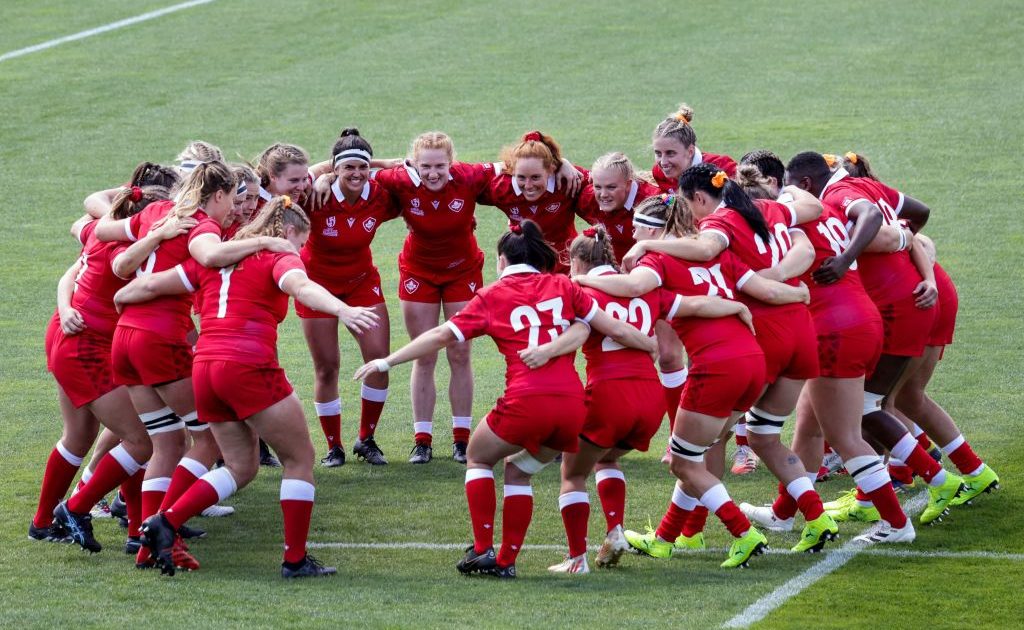Why combining Canadian Women 15s and 7s could reap rewards

A new spirit of collaboration is sweeping through Rugby Canada with the hope it will net long term rewards.
Over the past year, there’s been a gradual coming together of the women’s 15s and sevens programmes, with players and coaches alike splitting their time between the two sides.
With both teams heading towards major pinnacle events over the next two years, it will make for a logistically challenging time and while conceding it’s not perfect, 15s coach Kevin Rouet says it’s a way for them to build depth across their teams and ensure players are getting valuable match time.
Having been appointed to the role just eight months before last year’s World Cup, Rouet and his sevens counterpart Jack Hanratty, confirmed in his post a few months prior, came to a quick realization of what needed to happen for Canada to be more successful.
“We don’t have a depth of athletes like England, France, and New Zealand that maybe have an infinite pool of players. This is not our case, so if we are not willing to share athletes between the programs, we won’t be successful.”
Post the 2021 World Cup (played in 2022), Madison Grant and Alysha Corrigan were the first two to make the switch to the shortened format, joined by 15s captain Sophie de Goede and fullback Sabrina Poulin later in the season.
Standout halfback Justine Pelletier was included in the recent sevens squad which qualified for the Paris Olympics. On the flip side Fancy Bermudez, Florence Symonds, and Oliva Apps have made their fifteens debuts this year, while sevens flyer Krissy Scurfield has been named in the squad for the upcoming two-test series against England.
Also included to play England is 2014 World Rugby Women’s Player of the year Magali Harvey, returning to the Canada set up for the first time since 2018.
Rouet credits new Rugby Canada CEO Nathan Bombrys for backing their plan to get off the ground.
“It isn’t an easy thing for Jack and I to try and implement and would have been impossible if we didn’t have someone above us who was so willing. I can see a huge difference in the past six months [since Bombrys’ arrival] …there is more emphasis on us and more willingness to help us be successful three years out from a World Cup. Previously people have only cared a year out and you can’t win a World Cup if you think like that, having to catch up every time.”
To say the endeavor isn’t an easy one may be a slight understatement. In a country as vast as Canada, with some players centralized in Langford, others signed to European clubs and with an increasingly jammed rugby calendar, it’s a major undertaking.
There’s also the not insignificant factor that players like Scurfield and Symonds have are completely new to the 15s game.
“Some of them never played 15s in their lives before they trained with the national team because they were in the sevens environment from a very young age. You can see the potential they have, but we also don’t have a high-quality enough league for them to play in to get more playing experience” says Rouet.
While it means there will be mistakes made in the heat of the test arena, Rouet says what they lack in rugby experience they make up for in being very smart, hardworking athletes who can see the growth of the game and want to be part of it.
“They watch a lot of games to try to understand their roles and they’re willing to learn by watching, by talking. It was very challenging for someone like Flo who I put on the wing against New Zealand in what was her first game of fifteens, and while she made some mistakes, she’s an amazing rugby player so it’s a very easy fix sometimes.”
Clear communication and plenty of advanced planning are critical to the success of the collaborative approach. In conjunction with Bombrys and new high-performance director Stephen Aboud, who had great success with Italy, Rouet and Hanratty have a clear plan for the busy year ahead.
“For now, we’ve made the decision that the tests against England and WXV are the priority, and after that, from January, the focus will be Sevens and the Olympics,” Rouet says. “So next year for me in Pacific Four I won’t get any sevens players come to fifteens, but at least we’ve already invested in them before and we think it’s the best way if we want to have the best players on both sides.”
Rouet hopes that whenever the time comes for him and Hanratty to move on they’ve set a foundation for the future that could become Rugby Canada’s long-term advantage over other teams. He knows the reality is that leagues in England and France will increasingly cap the number of foreign players in each squad, so the time may come when they have to bring everybody home and create their own competition, and talent spot great athletes beyond the university system.
In the near future though, WXV is a game changer. With two warm-up tests against England this month prior to the competition in New Zealand starting in mid-October, it means Canada will have played an unprecedented eight internationals by the end of the year. While he describes this year’s WXV as his “last dance” with the full squad until after the Paris Olympics, Rouet hopes the foundation will be laid for success in 2025.
“We want to try to create a blueprint, a base and chemistry before they go away. There will be new players coming into this environment, so it’s going to be a balance and we will have to be very efficient, but keeping the same core group for a couple of months means we aren’t redoing things and we’re moving forward.”
































